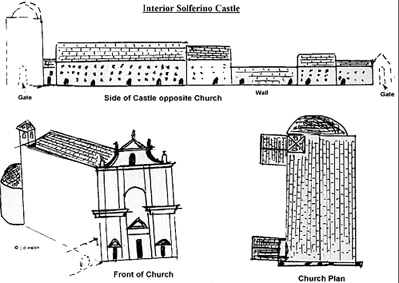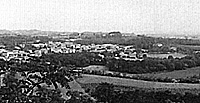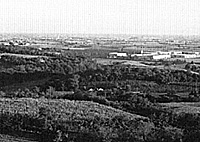This was the hardest area to research and with either misleading or the least amount of information. It also doesn't help when you consider Napoleon's clever (but to researchers and wargamers, frustrating) habit of continually transferring troops from one division to another. For example, in the O/B's for the French Army in Italy, 20-25th July, we find that Massena's Division numbers twice as many as that of Augereau. But ten days later at the battle of Castiglione, this appears to have been reversed. So, like Chandler and many others before me, I'm afraid I can only offer a calculated guess at the units involved.
ORDERS OF - BATTLE:
NB: Total numbers are those actually engaged in fighting at some time during the 5th of August, 1796.
FRENCH
-
Commander in Chief: General Napoleon Bonaparte
Division: Andre Massena
(Approx: 3 x Demi-Brigades) 6,000
Division Pierre Augereau
Approx: 4 - 6 x Demi-Brigades + possibly 10 x 8pdr foot 11,500
Verdier (in 3 x Grenadier battalions) 1,500
General Beaumont 2,500+ cav.
Total 21,500
General Fiorella 500 cav
(Approx: 2-3 Demi-Brigade.) 5,000
Adjutant General Leclerc
(4th/5th Demi-Brigades) 5,000+ inf
Combined Total 32,000
30 guns:- 18 x 4pdrs Horse Artillery and 12 x 8pdrs Foot.
AUSTRIANS
- Commander in Chief Feldmarschall Count Dragobert Wurmser
At least 22 battalions including the 3 x bats DM Regiment on Solferino Heights 22,000 Inf
3,000 Cav
3pdrs, 6pdrs, 12pdrs and possibly some captured French 8pdrs 30 guns
Total 25,000
On the way from Peschiera under Bajalich & Colonel Weidenfeld 5,000+
Combine Total 30,000
POSSIBLE FRENCH REGIMENTS AT CASTIGLIONE:
INFANTRY:
- Line Demi-Brigades: 4th/5th/11th/18th/19th/45th/32nd/39th
- 51st/69th/85th
Legere Demi-Brigades: 4th/11th/12th/18th/22nd/27th
- 5th Batallion des Alpes
5th/6th/7th Grenadier Battalions
CAVALRY:
- 5th/8th/15th/20th Dragoon regiments
7th Hussar regiment
10th/15th/22nd/24th Chasseur a Cheval Regts
DEFINITE AUSTRIAN UNITS AT CASTIGLIONE:
- KK IR4 Deutschmeister Regiment
POSSIBLE AUSTRIAN GRENADIER REGIMENTS AT CASTIGLIONE
- Wollzogen 11/18/21 (German Uniform)
L'Aisne: 3/4/46 (German Uniform)
Kottulinsky 41/50/59 (German Uniform)
Gavissini 23/24/49 (German Uniform)
Strassoldo 9/30/55 (German Uniform)

Wargaming:
Everyone has their own rules so I'm not delving into that area, but the battle itself can be fought whole or in parts. One game could concentrate on the French attacking the Castle and Solferino Heights. It must be noted that, although the steep hills and trees would normally give the advantage to a defender by breaking up larger formations and hindering artillery fire, it might also favour the tactics of the French mass skirmishers.
Also note that the castle outside walls in some places are not very high and easily climbable without ladders. However, on the other hand, the hills, trees and shrubbery surrounding it, should certainly help make it a difficult target for artillery. The castle was said to have a drawbridge on one of the gates, which I suspect was the gate nearest the Rocca Tower.
Another game could be based on taking Monte Medolano. This would offer an opportunity of using Horse Artillery against heavier guns in a redoubt. It might not sound exciting but consider the following from Chandler's Campaigns of Napoleon, written by Chef de bataillon Marmont when ordered to move his pieces into action:
"The enemy's calibre was superior to mine: I could only engage him by advancing a great way forward, and although the countryside was open, there was one defile to cross before I could deploy at a convenient range. Enemy shot was raking this defile, which was narrow enough. So I crossed it in sections of two guns at a time; after placing at its head the company in which I had the least confidence, I rushed my column forward at a gallop; the leading unit was duly wiped out, but the rest of my artillery rapidly deployed and unlimbered at short cannon range."
This action is ideal for the 'little corporals' amongst us and part of this action would include using the cavalry. It should be noted however, that throughout the battle it appears the cavalry's role appeared to be reduced to that of scouting, screening movements, covering retreats and counter-attacks.
 If the game is fought as a whole (photo at right: panorama of battlefield looking south from southern end of the castle) then the French, to obtain victory, must aim to capture the Solferino Heights and Monte Medolano and turn the Austrian left wing. For the Austrians, they must aim to hold their positions until reinforcements arrive from Peschiera.
If the game is fought as a whole (photo at right: panorama of battlefield looking south from southern end of the castle) then the French, to obtain victory, must aim to capture the Solferino Heights and Monte Medolano and turn the Austrian left wing. For the Austrians, they must aim to hold their positions until reinforcements arrive from Peschiera.
I fought the game as it happened in 1796, using 6mm figures and buildings, obtained from Heroic and Ros and the exciting new Revolutionary range from Irregular Miniatures.
(Well, I think they're exciting, anyway) I played until the Austrians retreated and the fresh units from Peschiera arrived. The result was that history repeated itself almost one hundred percent, right down to the first horse artillery unit being knocked out of action. The Austrians from Peschiera appeared on the scene too late and, as in reality, were able only to cover the retreat. But, who knows what might happen in another game?
You can, as I did, also add what I call an 'exciter'. The French morale would surely be lowered when ordered so early on to fall back, while the Austrians morale would rise. The French also suffered from some confusion when they were later ordered to attack again, which, as we saw, led to a delay in pinning down the Austrians in time for Fiorella's arrival. However, in my case, rather than just have the Austrians advancing immediately the French fall back, I let a throw of the dice decide. An even number meant the Austrians leave their positions while an odd number meant the French had to attack again until the next move, and the dice was rolled once more. This should be continued until the Austrians advance. In my game, however, the first dice rolled even and history was repeated once more.
 The battle starts at 6am but the ending is unclear, although Chandler times it at around 7.30pm. Fiorella appears to have arrived late in the morning (in photo, center background. View from Rocca Tower. Monte Feline in center), so that could be anywhere between 10 and 12 noon. The 4th and 5th Demi-Brigades may have arrived around 1-2pm. The following should also be noted: French cavalry on right flank to be used only to cover the advance of the Horse Artillery, and later, when Monte Medolano is taken, a brigade may advance around it, followed by Marmont and guns. They can then be used against opposing cavalry if the situation arises, although the Austrian cavalry were generally used only in counterattacks and to cover the retreat.
The battle starts at 6am but the ending is unclear, although Chandler times it at around 7.30pm. Fiorella appears to have arrived late in the morning (in photo, center background. View from Rocca Tower. Monte Feline in center), so that could be anywhere between 10 and 12 noon. The 4th and 5th Demi-Brigades may have arrived around 1-2pm. The following should also be noted: French cavalry on right flank to be used only to cover the advance of the Horse Artillery, and later, when Monte Medolano is taken, a brigade may advance around it, followed by Marmont and guns. They can then be used against opposing cavalry if the situation arises, although the Austrian cavalry were generally used only in counterattacks and to cover the retreat.
More Castiglione
More in the Series
Back to Table of Contents -- First Empire #23
Back to First Empire List of Issues
Back to MagWeb Master Magazine List
© Copyright 1995 by First Empire.
This article appears in MagWeb (Magazine Web) on the Internet World Wide Web. Other military history articles and gaming articles are available at http://www.magweb.com